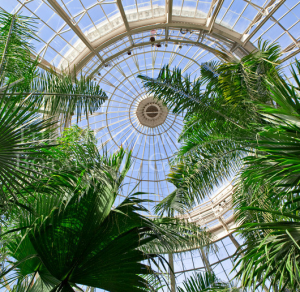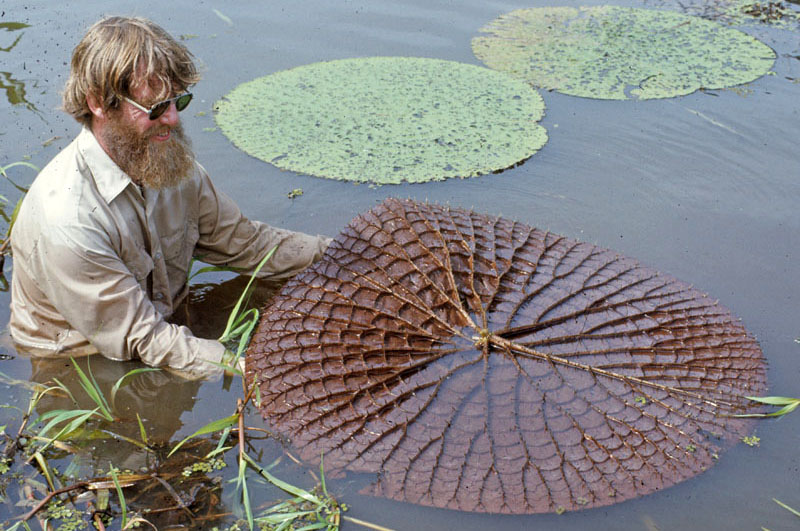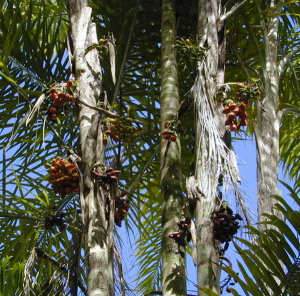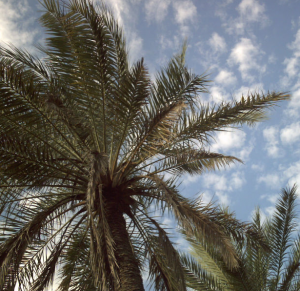A Glasshouse of Collected Stories
Posted in Horticulture on January 5 2015, by Christian Primeau
Christian Primeau is the NYBG‘s Manager of the Enid A. Haupt Conservatory.

The historic Enid A. Haupt Conservatory is well known for extraordinary seasonal exhibitions. The Holiday Train Show delights winter-weary visitors with festive lights, New York landmarks artfully crafted from natural materials, and myriad model trains chugging through a whimsical tropical landscape. The Orchid Show electrifies the senses, offering a veritable jungle of astonishing colors, forms, and perfumes. The annual spring-autumn exhibition showcases kaleidoscopic plantings and has recently paid homage to Monet’s garden at Giverny and the Abby Aldrich Rockefeller garden in Seal Harbor, Maine. Beginning May 16th, 2015, the vibrant Mexican garden of artist Frida Kahlo will find an ephemeral home right here in the exhibition houses.
All of these shows certainly warrant a visit, but I strongly encourage visitors to delve into the permanent glasshouse plant collections as well. This incredibly diverse assemblage, comprised of over 20,000 plants from around the globe, is the soul of the Conservatory. Since the grand building’s completion in 1902, many of these specimens have been collected by some of the most distinguished botanists and horticulturists of the era—from our founder Nathaniel Lord Britton to Sir Ghillean Prance.
The glasshouse collection forms a priceless living history, a record of The New York Botanical Garden’s roots and a symbol of its progress. It is a legacy passed down from plant lovers for plant lovers for 113 years. Think of it—the Ottoman Empire was still around when some of this material started growing in our glasshouses! Man had yet to reach the North Pole! Teddy bears, corn flakes, cubism, the Theory of Relativity, the Wright brothers’ airplane, the NYC subway—none of these existed when some of these plants were brought here. How’s that for perspective? We have learned and still stand to learn a great deal from this collection. On top of it all, it’s just so very nice to look at.
I’ve said it many times before, but one of the greatest thrills of working with such a historic collection is the story behind many of the plants. Very often, it’s the tale that draws you in. The story establishes a connection, the connection sparks an interest and, we hope, that interest will blossom into a passion. The passion for plant life is something we here at the garden, and so many others throughout the world, share and understand.

I mentioned Sir Ghillean Prance, a man who contributed greatly to the garden from 1963–1988 before moving on to lead the Royal Botanic Gardens at Kew. Somewhat like a British Indiana Jones, he holds a Doctorate in botany instead of archaeology and sports a trademark beard instead of a fedora. He has traveled the world, exploring the deepest rainforests and, on a handful of occasions, has risked his life to collect specimens for study and display. I recently heard him tell (and you may read about it in his latest book) of the time he was stranded in the deep Amazon and quickly running out of food. Down to a tiny container of canned meat, he was forced to scavenge the jungle for sustenance. He eventually came upon a stand of peach palm (Bactris gasipaes), the fruit of which is quite nutritious when boiled. This meager fare sustained him until help finally arrived.

You will find the peach palm thriving in the majestic Palm Dome at the Conservatory, grown from seed collected by Prance over 36 years ago. (Important to note should you find yourself stranded in the Conservatory with naught but a can of SPAM.)
We recently introduced another palm to the collection with an interesting back story. In early 2003, a young Army sergeant (and my childhood best friend) was attached to a Special Forces unit laying low in an unlikely place. If you asked him in years prior if he’d ever envision himself loosening his combat boots for a break in Saddam Hussein’s private quarters, he likely would have given you the side-eye. As the American spearhead drove into Baghdad, however, his unit set up shop in Mr. Hussein’s lavishly appointed Presidential palace on the banks of the Tigris. He was soon dozing on a silk divan beneath a colossal painting of the dictator astride a rearing white steed reminiscent of Jacques-Louis David’s “Bonaparte Crossing the Alps.”

Thanks to a few well-aimed carbine rounds, heaps of plump, sweet dates from a tall date palm (Phoenix dactylifera) at the center of Saddam’s lush private garden filled his pack. These he relished, discarding the seeds as he moved through the desert save a handful which he dried on the broiling dashboard of his Humvee. Those extraordinary seeds eventually made the arduous 8,500-mile journey via Kuwait, Qatar, and Kaiserslautern to my living room where they readily germinated. To this day when I look at this amazing little palm (one of Enid A. Haupt’s favorite plants, by the way) I can’t help but picture Saddam in repose beneath the mother tree, relishing that fruit. Surely he must have! I often wonder if that palm still stands today.
These are but two of thousands of stories that enrich the already brilliant collection for which I am incredibly fortunate to act as temporary steward. The plants all have undeniable aesthetic, scientific, and educational significance, but unique stories provide an intangible, immeasurable, and wholly personal value that cannot be denied. I encourage you to visit, explore, and learn more about the collection. Hopefully you will come to love it as we do.


Christian,
This blog is the BEST! So many wonderful stories to enjoy. What a gift to all your readers! Sue